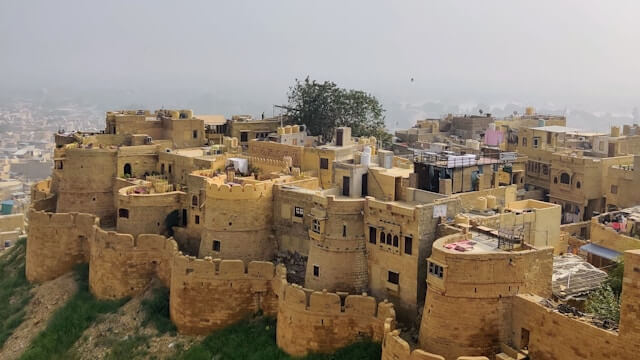Jaisalmer is set amidst the arid Thar Desert. Jaisalmer Fort is the most prominent feature of the city and is made up of yellow sandstone. The beautiful hue of the fort lends a stark barren look as it stands atop the cliff of Trikuta Hills and has stood up to the dry stormy winds and the scorching sun for centuries, ever since it was built in 1156. Some people even claim that materialization of this fort was prophesized by Lord Krishna, the head of Yadav clan long ago. Rawal Jaisal from Bhatti Rajput clan founded the city and the fort. He conceptualized this new capital for his princely estate after deserting Lodurva fort. The location was chosen as it was on the ancient silk route and hence, soon evolved into an important trade and commerce center. Natural beauty takes a very different meaning at Jaisalmer as we become acquainted with the beauties of the extreme climate and get to look at natural elements beyond the waterfalls, rivers and the greens.
The blinding windstorms of the desert, the rolling movements of the hump-backed camels, the haunting music and dexterous steps of the desert natives that have faced the extreme climate for generations and the sand dunes that move like tall sea waves, all lend an ‘Arabian Night’ feel to the city. Then there are charming legends related to medieval concepts of valor, chivalry and romance that still haunt every nook and corner of the fort. The daunting structures with delicately latticed stonework and the dark brown people dresses in multicolored attires attract the tourists. The turbans and the moustaches of the makes and the unique jewellery designs and long-flowing skirts of the women are not less interesting.
Jaisalmer’s Prime Attractions
Jaisalmer Fort
The second oldest fort of Rajasthan, Jaisalmer Fort is from the 12th century and stands atop the 250 ft high hill that provides some of the fantastic views of the desert around the city. The four gateways that one has to pass through before reaching the fort are Akhai Pol or Ganesh Pol, Suraj Pol, Bhuta Pol and Hawa Pol.
Salem Singh ki Haveli, Patwon ki haveli and Nathmal ki Haveli
Havelis of Jaisalmer were the magnificent houses of the rich merchants of the former kingdom and exude architectural and sculptural perfection and grandeur. The blossoming wild flower at the top of the Salem Singh ki Haveli, Patwon ki Haveli that reflects the intricate brocade, gold and silver embroidery work designs, the business of its owners that extended from Afghanistan to China, and Nathmal ki Haveli built in 1885 by Nathmal and his brother as a gift to the Rawal or the Prince of the estate. However, they were allowed to retain it.
Gadsisar Lake
The rainwater lake showcases the evolution of the concept of the rainwater conservation in the ancient times and has managed to create an oasis in the desert with green environs. There are small temples around it along with a beautiful museum and many folklore tales are woven around the area.
Sam Sand Dunes
Sam sand dunes, 42 m from Jaisalmer, are quite famous. It is situated at the borders of the Desert National Park. The sunsets and sunrises here are quite like a fairy tale setting while camel rides give you a feel of being a part of the desert country.
Desert Festival
The three-day long Desert festival showcases the imperial, virant, rich and colorful culture of Rajasthan with Gair and Fire dancers as its highlights along wit the camel polo and camel dance, the two unique and exclusive events organized here. Other interesting events to look at are the turban tying competition and display of long glorious moustaches by the natives.
Location
Situated in western Rajasthan. It is 413 km from Jaipur and 630 km from Delhi.
Climate
Jaisalmer has a typical desert climate with scorching and dry summers and stormy and chilly winters.
 919037789225
919037789225
 info@europeaninindia.com
info@europeaninindia.com





Comments On "Jaisalmer"